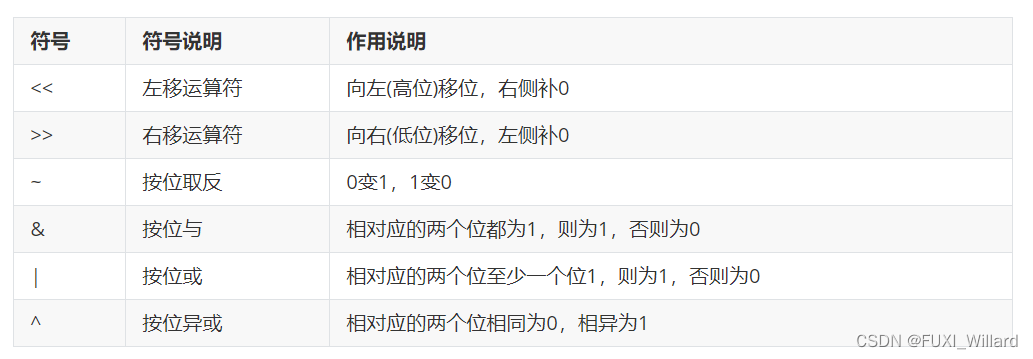学习网站:C语言网.
编译器:Red Panda Dev-C++
1.位运算符表

#include <stdio.h>
int main(){
int numberOne,numberTwo;
// 13左移两位过程(4个字节):
// 移位前:13==>0000 0000 0000 0000 0000 0000 0000 1101
// 左移后:0000 0000 0000 0000 0000 0000 0011 0100==>52
numberOne = 13 << 2; // 左移N位,乘以2的N次方;
numberTwo = 25 >> 3; // 右移N位,除以2的N次方;
printf("numberOne = %d,numberTwo = %d\n", numberOne, numberTwo);
return 0;
}
2.按位与&运算符
// 1.同为1时,结果为1;
// 2.按位与运算符作用:
// 2.1 清零:对某一个数与0进行按位与,最终全部位变为0,起到清零作用;
// 2.2 取指定位:如取第1-3位表示xxx,则让原数值与数字7(0111)进行按位与运算;
// 2.3 判断奇偶:数字的奇偶取决于二进制位的最低一位是1还是0,与1按位与运算,判断是1是0即可判断奇偶;
/*
实例说明:3和5按位与运算
3==>0000 0000 0000 0000 0000 0000 0000 0011
5==>0000 0000 0000 0000 0000 0000 0000 0101
&==>---------------------------------------
0000 0000 0000 0000 0000 0000 0000 0001==>十进制1
*/
#include <stdio.h>
int main(){
int numberOne;
int numberTwo;
int numberThree;
numberOne = 3 & 5; // 见分析过程,其他数同理;
numberTwo = 0 & 1;
numberThree = 5 & 5;
printf("The result of 3 & 5 = %d\n", numberOne);
printf("The result of 0 & 1 = %d\n", numberTwo);
printf("The result of 5 & 5 = %d\n", numberThree);
return 0;
}
3.按位或|运算符
// 1.两个对应二进制位有一个为1,结果为1;
// 2.按位或运算符作用:对一个数字指定位置为1;
// 如某个数字的第七位表示开关,原先为0,需要改为1的状态,可以将这个数字与64(0100 0000)按位或,即可得到第七位变为1,其余为的值不变;
/*
实例说明:8和7的按位或运算
8==>0000 0000 0000 0000 0000 0000 0000 1000
7==>0000 0000 0000 0000 0000 0000 0000 0111
|==>---------------------------------------
0000 0000 0000 0000 0000 0000 0000 1111==>15
*/
#include <stdio.h>
int main(){
int numberOne;
int numberTwo;
int numberThree;
numberOne = 8 | 7;
numberTwo = 8 | 0; // 0(... 0000 0000)
numberThree = 8 | 15; // 15(... 0000 1111)
printf("The result of 8 | 7 = %d\n", numberOne);
printf("The result of 8 | 0 = %d\n", numberTwo);
printf("The result of 8 | 15 = %d\n", numberThree);
return 0;
}
4.按位异或^运算符
// 1.按位异或:相异,结果为1;相同,结果为0;
// 2.按位异或作用
// 2.1 指定位数翻转:如想对某个数字低4位进行翻转,可以与15(0000 1111)进行按位异或运算;
// 2.2 与0异或还是原值;
// 2.3 交换两个数字;
/*
实例分析:15和16按位异或运算
15==>0000 0000 0000 0000 0000 0000 0000 1111
16==>0000 0000 0000 0000 0000 0000 0001 0000
^ ==>---------------------------------------
0000 0000 0000 0000 0000 0000 0001 1111==>31
*/
#include <stdio.h>
int main(){
int numberOne;
int numberTwo;
numberOne = 15 ^ 16;
numberTwo = 15 ^ 0;
printf("The result of 15 ^ 16 = %d\n", numberOne);
printf("The result of 15 ^ 0 = %d\n", numberTwo);
return 0;
}
#include <stdio.h>
int swap(int *a,int *b){
*a = *a ^ *b;
*b = *b ^ *a;
*a = *a ^ *b;
}
int main(){
int a = 3;
int b = 5;
//printf("Initial a = %d.Initial b = %d\n",a,b);
swap(&a, &b); // 交换a和b的值;
printf("a = %d b = %d\n",a,b);
return 0;
}
5.按位取反~运算符
// 1.按位取反:对数值的二进制位进行取反;
#include <stdio.h>
int main(){
// 把下列数的二进制写出来,然后取反理解;
unsigned int numberOne = 1;
int numberTwo = 1;
int numberThree = 0;
int numberFour = 10;
printf("~1 = %u\n", ~numberOne);
printf("~1 = %d\n", ~numberTwo);
printf("~0 = %d\n", ~numberThree);
printf("~10 = %d\n", ~numberFour);
return 0;
}
